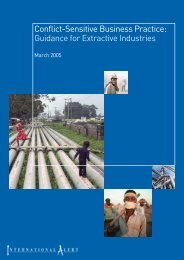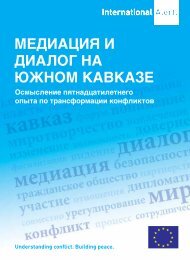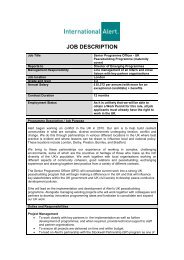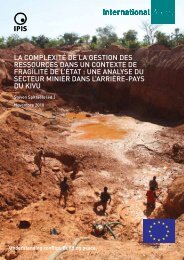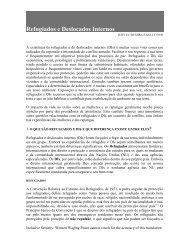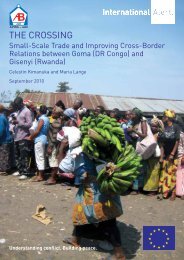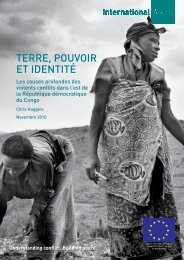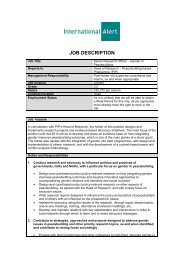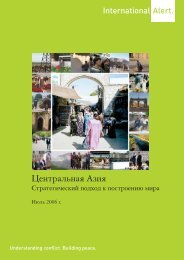8 International Alert1. Introduction<strong>What</strong> is <strong>peace</strong> in South Sudan <strong>and</strong> Sudan? <strong>What</strong> <strong>peace</strong> is there, <strong>and</strong> whom does it serve? Howmight it be made better; for example, be made more comprehensive, more stable <strong>and</strong> more lasting?Such questions are fundamental to the future of the two Sudans, <strong>and</strong> there are strong reasonsfor asking those questions. Despite the six-year Comprehensive Peace Agreement (CPA) <strong>and</strong> thesecession of South Sudan in 2011, <strong>peace</strong> in South Sudan <strong>and</strong> Sudan remains fragile. Violence <strong>and</strong>violent conflict have continued to occur, <strong>and</strong> risks <strong>and</strong> fears of future conflict have not faded. Thisis true in each country, <strong>and</strong> it is true about present <strong>and</strong> future relations between the two countries.With the belief that a more stable <strong>and</strong> more comprehensive <strong>peace</strong> is possible, this paper exploressome profound questions about <strong>peace</strong> <strong>and</strong> <strong>peace</strong>building in South Sudan <strong>and</strong> Sudan. The paper doesnot prescribe answers, nor does it aim to be exhaustive: building <strong>peace</strong> is a process, <strong>and</strong> ultimatelyit is the people of South Sudan <strong>and</strong> Sudan who will or will not build a more <strong>peace</strong>ful future for theircountries, their children <strong>and</strong> future generations. However, by asking questions <strong>and</strong> looking at someways in which <strong>peace</strong> <strong>and</strong> <strong>peace</strong>building can be understood <strong>and</strong> pursued, this paper hopes to foster <strong>and</strong>contribute to debate within <strong>and</strong> between South Sudan <strong>and</strong> Sudan about what can <strong>and</strong> should be doneto reduce the risk <strong>and</strong> incidence of violent conflict, <strong>and</strong> to strengthen <strong>peace</strong>.Underpinning the paper’s aims, <strong>and</strong> the analysis <strong>and</strong> arguments it contains, is the concept ofpositive <strong>peace</strong> as understood by International Alert. This is a concept of <strong>peace</strong> as a dynamicstate within which conflicts <strong>and</strong> differences are managed <strong>peace</strong>fully, without violence, rather thanneglected or suppressed. In line with this concept, the paper uses a framework of five fundamentalfactors of conflict <strong>and</strong> <strong>peace</strong> in order to explore the present nature of <strong>peace</strong> in South Sudan <strong>and</strong>Sudan <strong>and</strong> future possibilities. These factors are:• Power: how power is held <strong>and</strong> used;• Economy: how the economy is structured <strong>and</strong> who benefits;• Fairness: how fair <strong>and</strong> effective are the law <strong>and</strong> its implementation;• Safety: the degree to which people feel or are safe;• Well-being: the quality of people’s lives.These factors are interconnected <strong>and</strong>, in one guise or another, they underlie most violent conflicts<strong>and</strong> examples of <strong>peace</strong> around the world. Considering these factors can help in answeringquestions about how <strong>peace</strong> should be defined <strong>and</strong> what kind of <strong>peace</strong> should be aimed for.International Alert (hereafter Alert), an international <strong>peace</strong>building organisation, has been researchingSouth Sudan <strong>and</strong> Sudan from a <strong>peace</strong>building perspective since 2006. During this time Alert hasobserved that <strong>peace</strong>making <strong>and</strong> <strong>peace</strong>building efforts in the now two countries have recurrentlysuffered from the lack of a consistent <strong>peace</strong>building framework. This shortcoming has in part beenbecause those involved in <strong>peace</strong>making <strong>and</strong> <strong>peace</strong>building have tended to be constrained by politicalcircumstances <strong>and</strong> m<strong>and</strong>ate, <strong>and</strong> take a too-narrow view. Alert has therefore published this shortpaper to illustrate how a coherent <strong>peace</strong> <strong>and</strong> <strong>peace</strong>building framework might be used.Conflict <strong>and</strong> <strong>peace</strong> in South Sudan <strong>and</strong> SudanConflict in South Sudan <strong>and</strong> Sudan occurs at national, sub-national <strong>and</strong> local levels. After theformal end of the civil war in 2005, Sudanese <strong>and</strong> international concern about <strong>peace</strong> in Sudanwas concentrated on the CPA <strong>and</strong> the technicalities of its implementation <strong>and</strong>, to a lesser extent,
<strong>What</strong> <strong>peace</strong> <strong>and</strong> whose?9on the Darfur conflict <strong>and</strong> the various unsuccessful attempts to formally end the conflict. As al<strong>and</strong>mark <strong>peace</strong> agreement which brought formal <strong>peace</strong>, the CPA needed close attention, bothdomestically <strong>and</strong> internationally. However, the focus on the CPA also led to a preoccupationwith short-term targets <strong>and</strong> deadlines, <strong>and</strong> a lack of attention to deeper, longer-term issues<strong>and</strong> problems which are themselves underlying drivers of discontent <strong>and</strong> conflict within eachcountry as well as between them. Essentially the CPA was a high-level political <strong>and</strong> militaryagreement, which did little to mitigate feelings among many people about issues such asinequality, discrimination, injustice, impunity <strong>and</strong> corruption – issues connected to the fivemain factors of conflict listed above. Thus, although the CPA brought some <strong>peace</strong>, it is alsotrue that it did not build <strong>peace</strong> comprehensively. It was comprehensive neither geographicallynor in which factors of conflict it addressed.Since the end of the CPA in July 2011 <strong>and</strong> the secession of South Sudan, <strong>peace</strong> in the two Sudanshas not suddenly become stronger or deeper. On the contrary, regardless of the arrangementswhich are meant to provide for <strong>peace</strong> between the two countries in this post-CPA period, thosefactors of conflict which have not been addressed since 2005 (<strong>and</strong> before) remain present <strong>and</strong>continue to pose a threat to future <strong>peace</strong> <strong>and</strong> stability in <strong>and</strong> between both countries. The list offactors is long, but however they are categorised or discussed, many of them are familiar to peoplefrom across the two countries, as Table 1 shows.Table 1: Some factors blocking progress in <strong>peace</strong> in South Sudan <strong>and</strong> SudanIssueDemocracyDiscriminationImpunityInequalityEconomicdiscontentLack ofreconciliationOilCorruptionPatronageIdentityIdeologyExample or illustrationElections are not seen to be free <strong>and</strong> fair, contributing to perceptions thatgovernments are not representative, <strong>and</strong> encouraging rebellions against themPeople feel that there is ethnic favouritism in government, in private sectoremployment opportunities <strong>and</strong> in access to services; minority ethnic groups feelmarginalised <strong>and</strong> disadvantagedPerpetrators of violence <strong>and</strong> abuses are seen to go unpunished, encouragingpeople to pursue retributive <strong>and</strong> retaliatory violence, <strong>and</strong> encouraging cynicismabout the political <strong>and</strong> judicial systemsGap between rich <strong>and</strong> poor is seen to have widened <strong>and</strong> access to wealth is seenas linked to aspects of identity such as tribe, geographic location <strong>and</strong> genderDiscontent about unequal regional economic <strong>and</strong> infrastructure development,which can encourage dem<strong>and</strong>s for regional self-determinationHistorical grievances, suspicions <strong>and</strong> mistrust between communities are notaddressed, contributing to ongoing animosityCommunities feel that the negative impact of oil exploration <strong>and</strong> production isinsufficiently addressed <strong>and</strong> local benefits are too fewPerceptions that corruption goes unpunished undermine public confidence in <strong>and</strong>support for central <strong>and</strong> local governmentExpectations of patronage conflict with expectations of equity <strong>and</strong> equalopportunityCompeting claims about local or regional identity lead to conflict <strong>and</strong> violence, forexample over l<strong>and</strong> rights <strong>and</strong> ownershipPerceived attempts to implement a particular ideology (for example relatedto national or religious identity) are sometimes inflammatory <strong>and</strong> opposed bysections of the population





